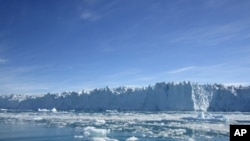Ice sheets in Greenland and Antarctica are losing mass at an accelerating rate, according to a new study based on nearly two decades of satellite measurements and regional climate models.
"What we’re seeing in both Greenland and in Antarctica is an increase in the mass loss of the ice sheets," says lead author Eric Rignot, whose findings are published in the March edition of Geophysical Research Letters. "Not only are the ice sheets losing mass to the ocean, but the mass loss is increasing every year."
According to the authors, ice sheets that cover huge land masses are diminishing three times faster than those from the smaller ice caps and mountain glaciers. Rignot, a glaciologist with the University of California and NASA’s Jet Propulsion Laboratory, says that was not unexpected.
"Right now they are running neck to neck, but if the trends in both mountain glaciers and ice sheets continues this means that ice sheets will eventually become dominant contributors to sea level rise," he says, "and it is sort of not surprising because they do hold a lot more ice, and so they have a lot more potential for raising sea level."
The study predicts that sea level will rise 32 centimeters by 2050, almost half of that from the Greenland and Antarctic ice sheets melting at the current pace. Rignot says that’s higher than what the United Nations Intergovernmental Panel on Climate Change (IPCC) has projected.
"This means that some of their predictions made in the last IPCC report are called into question and the role of ice sheets is not something that is secondary in examining future sea level," says Rignot. "It’s probably one of the centerpieces of future sea level rise and this study confirms that this is indeed the case."
He says the study proves global warming is real and a big concern, especially for people in coastal areas, giving them less time to respond to rising seas. According to Rignot, warmer oceans could also drive the accelerated polar melting. "If these oceans are warming up, we have to understand how this is going to affect glacier ice and the flow of glaciers into the sea. Right now we are seeing that in places where the ocean gets warmer, it melts the ice faster at the periphery and the glaciers respond to that by flowing faster."
Rignot believes it is important to continue to monitor the ice sheets, and using that information along with historic data, begin to build models that can better predict ice sheet melt in the coming century.












